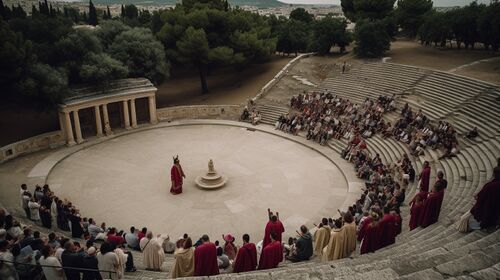The structure of Oedipus the King follows the conventions of classical Greek tragedy. The play maintains a well-balanced rhythm between action and reflection, advancing the plot while allowing for contemplation and analysis of the play’s central themes. It creates a sense of inevitability and tension as the tragic events unfold, leading to a climactic resolution in the exodos. The structure of the play contributes to its enduring power and impact, drawing audiences into the tragic world of Oedipus and inviting them to reflect on the complex themes presented.
Prologue
The play opens with a prologue, which sets the stage for the unfolding tragedy. The prologue introduces the main characters, the setting, and the central conflict. In Oedipus the King, the prologue establishes the plague that afflicts Thebes, the search for the cause of the plague, and Oedipus's determination to uncover the truth.

Parodos
The parodos is the entrance song of the chorus, a group of performers who provide commentary and interact with the main characters throughout the play. The chorus serves as a collective voice representing the citizens of Thebes and offers reflections, interpretations, and moral judgments on the events unfolding on stage. The parodos in Oedipus the King presents the chorus’ initial reaction to the plague and sets the tone for their subsequent involvement.
Episodes and Stasimon
The play unfolds through a series of alternating episodes and stasima (plural of stasimon). Episodes are scenes of action and dialogue between the characters, while stasima are choral odes that follow the episodes. The episodes advance the plot, reveal new information, and showcase the interactions between the characters. The stasima provide moments of reflection, commentary, and contemplation on the events of the play, often offering insights into the play’s major themes. They allow the audience to pause, reflect, and digest the unfolding tragedy.
Exodos
The exodos is the final scene of the play, serving as the conclusion and resolution. It typically features a speech or dialogue that wraps up the main events and offers reflections on the lessons learned. In Oedipus the King, the exodos reveals the devastating truth about Oedipus’ identity, leading to his self-blinding and exile. It emphasizes the tragic consequences of his actions and the themes of fate, knowledge, and personal responsibility.
Unity of Time, Place, and Action
Oedipus the King adheres to the Aristotelian principle of unity of time, place, and action. The entire play takes place within a single day, reflecting the concept of dramatic unity. The action is confined to Thebes, specifically the palace and its surroundings, maintaining a sense of geographical unity. The play focuses on a single central conflict—the search for the truth about the cause of the plague and Oedipus’ identity—which drives the narrative forward and maintains unity of action.
Chorus
The chorus plays a crucial role in the structure of Oedipus the King. Their presence and commentary contribute to the overall structure of the play. Through their interactions with the characters and their choral odes, the chorus provides moral and ethical reflections, offers interpretations of events, and serves as a mediator between the audience and the action on stage.
Dramatic Irony
Dramatic irony is a prominent literary device employed in Oedipus the King and contributes to the play’s overall impact and tragic effect. Dramatic irony occurs when the audience possesses knowledge or awareness that is unknown to the characters on stage, leading to a deeper understanding of the unfolding events and often heightening the sense of impending doom.
In Oedipus the King, the audience is aware of Oedipus’ true identity and the prophecy that he unknowingly fulfills, while Oedipus himself remains ignorant of these crucial facts. This creates a powerful dramatic tension as the audience witnesses Oedipus’ relentless pursuit of the truth, while simultaneously realizing that his search will ultimately lead to his own downfall.
The dramatic irony is established early in the play when Oedipus, in his role as the King of Thebes, vows to find and punish the murderer of King Laius, not knowing that he himself is the culprit. As the investigation progresses, Oedipus relentlessly seeks the truth, unaware that he is unraveling his own tragic fate.
The audience’s knowledge of Oedipus’ true parentage and the prophetic curse heightens the tension in key moments of the play. For example, when Oedipus accuses Tiresias, the blind prophet, of withholding information, the audience understands the irony as Tiresias, who is fully aware of Oedipus’ true identity, struggles to reveal the truth while being met with resistance and disbelief.
The dramatic irony reaches its climax in the final moments of the play. As Oedipus confronts the reality of his actions and the devastating truth is fully revealed to him, the audience experiences the tragic catharsis that arises from witnessing the downfall of a once-great and noble character. The contrast between the audience's knowledge and Oedipus's ignorance creates a profound emotional impact.
Through the skillful use of dramatic irony, Sophocles invites the audience to reflect on the limitations of human knowledge, the nature of fate, and the complexity of the human condition. The dramatic tension created by the disparity between what the audience knows and what the characters perceive enhances the tragic power of Oedipus the King and contributes to its enduring status as a masterpiece of Greek tragedy.
